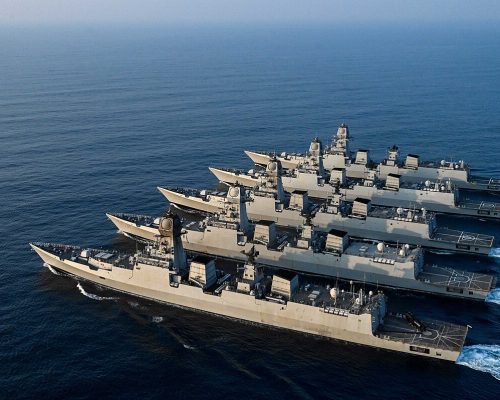Synopsis
In between the ongoing global conflicts and geopolitical turmoil, the Indian Navy is directing its efforts and energy toward upgrading its armed capability. the Indian Navy`s warship Design Bureau has recently introduced the next-generation destroyer concept under the name Project 18 (P-18).
It is a larger and more capable destroyer than the current Visakhapatnam-class destroyers. Having a displacement weight of 13000 Tonnes, with features of 144 vertical launch systems (VLS) & advanced radar system which can detect up to 500 km.
Indian Navy focuses on multi-domain operations with a focus on indigenous manufacturing and boosting India`s naval power. Indian Government and Indian Navy have jointly started their most advanced and ambitious warship program by the name Project 18 (P-18), designed to dominate the seas with unparalleled firepower and cutting-edge technology.
Table of Contents
What is Project 18
Project 18 is a Next-Generation Destroyer (NGD) program initiated by the Indian Navy, designed as a stealth guided missile destroyer. This class will serve as the successor to the current Visakhapatnam-class destroyers. It is part of the Indian Navy’s broader Next-Generation surface combatant series, which also includes the Project 17B-class frigates (Next-Generation Frigates or NGF) and the Next-Generation Corvettes (NGC).
What is a destroyer & its role
A destroyer is a fast, maneuverable, long-endurance warship designed to escort larger vessels in a fleet, convoy, or battle group and defend them against short-range attackers such as submarines, aircraft, and smaller surface ships. They are heavily armed and versatile, often considered the backbone of modern naval surface fleets.
Key Features of a Destroyer
Speed: Typically, over 30 knots.
Weapons: Equipped with missiles (surface-to-air, anti-ship, cruise), torpedoes, and guns.
Sensors: Advanced radar and sonar systems for air, surface, and underwater threats.
Multi-role: Capable of anti-air, anti-surface, and anti-submarine warfare (ASW).
Versatility: Operates in all environments — littoral (near-shore) or open sea.
Role of Destroyers in the Indian Navy
One of their primary roles is fleet defense, where they escort and protect high-value assets like aircraft carriers and amphibious ships from aerial, submarine, or missile threats. They also possess significant surface strike capabilities, being armed with advanced cruise missiles such as the BrahMos, allowing them to engage enemy ships and land targets with precision.
In the domain of anti-submarine warfare (ASW), destroyers are equipped with sophisticated sonar systems, torpedoes, and depth charges to detect and neutralize hostile submarines. For air defense, they employ surface-to-air missile systems that shield naval formations from enemy aircraft and incoming missile attacks.
Destroyers also serve a vital role in surveillance and electronic warfare, carrying state-of-the-art radar and electronic systems for long-range detection, tracking, and jamming of enemy communications and sensors.
As tools of power projection, Indian Navy destroyers participate in multinational naval exercises such as Malabar, VARUNA, INDRA. and TROPEX 2025, showcasing India’s maritime strength in international waters. Additionally, they contribute to Humanitarian Assistance and Disaster Relief (HADR) missions, rapidly responding to natural disasters by conducting evacuations, delivering relief supplies, and supporting rescue operations
Project 18 Design
In 2023 December, Vice chief of Naval Staff, Vice Admiral sir Sanjay Jasjit Singh, stated “The Indian Navy has started work on building the next generation of more advanced and capable destroyers, and plans for these vessels are already on the drawing board”. The current Vishakhapatnam-class destroyer which carries the largest displace weight of around 7450 tones and is ideal with 48 VLS (vertical Launch System). Compare to P-18 (Project 18) is capable of fitting 144 VLS cell supporting various missile roles for Indian Navy according to its needs.
Project‑18 Destroyer: India’s next-gen 13,000‑ton stealth warship with 144 VLS, 75% indigenous IEP, AESA radars & DEW-ready design. Future-ready, modular, & hypersonic-capable—putting India alongside Type‑055 & Arleigh Burke. #Project18 #IndianNavy #DefenseTech #MakeInIndiaAsk pic.twitter.com/HzZmVHMTG1
— Nikhil Maurya (@nikhilhatesyou) July 28, 2025
Missile configuration supports layered defense and strike roles of Project 18
As per the Naval Bureau the destroyer will be capable of featuring 144 vertical launch missile cells, which makes it the most capable warship in Indian Navy including:
- 32 VLS cells at the aft, equipped with the PGLRSAM air defence missile, capable of intercepting enemy aircraft and ballistic missiles up to 250 km away.
- 48 cells fitted with the BrahMos Extended Range cruise missile, as well as other long-range indigenous cruise missiles designed for land and maritime strikes.
- 64 VLS cells configured for very short-range surface-to-air missiles, providing the ship with a last line of defence against incoming threats.
- In addition, the ship will carry 8 slant launchers, likely for the hypersonic BrahMos-2, still under development.
With this layout Project 18 (P-18) will not only fully firepower but also, provide multi-layer of protection, multi-role defence, capable of targeting enemy aircraft, ship, missiles, submarines and any land installations.
Advance Radar and multi-role capacities of project 18
DRDO and BEL (Bharat Electronics Limited) had jointly developed its next-generation radar and sensor. Four large size Active Electronically Scanned Array (AESA) radars which includes S-band and volume-based search radar, which helps in giving 360-degree surveillance and track any aerial and or surface challenges up to 500 km.
This multi-use sensor mast and electronic warfare systems will not only uplift the operating capabilities but also, helps in making it the warship more stealth and involving jamming and cyber interference.
Indian Navy Next-Gen Destroyers will come with 144 VLS 🚀🇮🇳
— News IADN (@NewsIADN) July 26, 2025
Indian Navy Next Generation Destroyers under Project-18 (13,000 tons) are likely to have 32 VLS for LRSAM, 48 BrahMos ULVS and 64 smaller VLS for SAM with a total of 144 VLS on board. #IADN pic.twitter.com/1xmtmldwof
‘Make In India’ Core of project 18
Project 18 (P-18) strongly showcase the push for the self-reliance in armed force. About 75 percentage of the components and items will be indigenously build. The warship will also feature an IEP system (Integrated Electric prolusion), advance stealth shipping and also capable enough in operating underwater drones for any mine detection and or any anti-submarine operation. Two multi-role helicopters will also be deployed on board for any aided by less traversing system as a QRF (quick reaction force) for deployment and storage.
Expected timeframe and indigenous development of project 18
Project 18 (P-18) is projected to be completed by 2028 according to the latest projection made by the officials. And delivery is to be likely scheduled next decade. MDL (Mazagon Dock Shipbuilders Limited) and Garden Reach Shipbuilders and Engineers (GRSE) will spearhead production.
Indian Navy’s long-term expansion plans under project-18
Conclusion
Project 18 marks a major step forward in strengthening India’s naval power. With advanced stealth design, 144 vertical launch cells, and cutting-edge radar systems, these next-generation destroyers are built to dominate in multi-threat environments.
As India moves toward a 175-warship fleet by 2035, Project 18 will play a key role in countering regional challenges, especially in the Indo-Pacific and Indian Ocean. Most importantly, with over 75% indigenous components, it highlights India’s commitment to self-reliance and modern defense capabilities under the Make in India initiative.
“No” Third Aircraft Carrier: What It Means for the Future Indian Navy
The GeoLens – India || Defence || Global Affairs

Pratik Kondawale
Strategist | Indian Defence & Global Affairs
Founder of GeoLens.in, Pratik writes in-depth analysis on India’s defence strategy, military tech, and global power shifts delivering sharp insights through an Indian lens.


4 thoughts on “India’s Project 18 Destroyer: Armed with 144 Missiles including BrahMos with Surveillance Power up to 500 km”